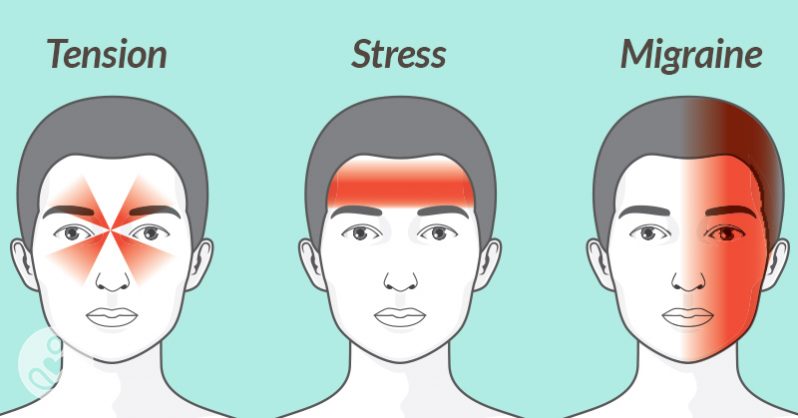A migraine is a severe, throbbing and distressing headache usually affecting one side of the head.
Migraine headache usually affects the young and middle aged, though described in all age groups including children.
More frequent in females and in those with family history in first degree relatives and typically decreases with advancing age.
Classically throbbing and severe, may also be dull and continuous. More often presents with disability and man-hour losses.
Usually hemicranial, may also be holocranial.
When hemicranial, it occasionally alternates sides.
May be episodic (occurs for less than 15 days in a month) or chronic if it occurs for more than 15 days in a month or 180 days in a year.
Episodes usually last between 4-72 hours in duration.
Symptoms of Migraine headaches
- Migraines may be preceded by focal neurologic features like visual symptoms of light flashes, zigzag lines, double vision, hemiparesis (weakness of one side of the body) or brief loss of consciousness. These features are called auras.
- Severe, throbbing and pulsating headache.
- Photophobia and or phonophobia may also be described. Increased sensitivity to light.
- Headache may be on one side of the head but can be on either side.
- Preceding focal neurologic features are called auras and usually last for less than 60 minutes.
- May be associated with nausea and or vomiting and occasionally seizures.
- Inability to perform regular activity because of pain.
- Pain may be localized just on one eye.
- Feeling unwell.
- Severe distress
- Increased pain on physical activity or when straining to urinate or defaecate.
- Other rare symptoms are stomach pain, temperature changes and diarrhea.
Classification of Migraine headache
May be subclassified broadly into:
i) migraine with aura(classic migraine)
ii) migraine without aura(common migraine)
Others(complicated migraine)
iii) hemiplegic migraines
iv) basilar type migraine
v) acephalgic migraine or migraine
equivalent
vii) ophthalmoplegic migraine
Causes of Migraines
Provocateurs/triggers of migraine attack
include:
- Physical, mental or emotional stress, fasting.
- Poor sleep
- Red wines and chocolates
- Menstrual cycle and contraceptive pills/injectables
- Drugs e.g. vasodilators like nitroglycerin and oral contraceptives pills can aggravate migraines.
- Hormonal changes in women: Fluctuations in estrogen seem to trigger headaches in many women. Women with a history of migraines often report headaches immediately before or during their periods, when they have a major drop in estrogen.
- Food additives.The sweetener aspartame and the preservative monosodium glutamate (MSG), found in many foods, may trigger migraines.
- Sensory stimuli.Bright lights and sun glare can induce migraines, as can loud sounds. Strong smells — including perfume, paint thinner, secondhand smoke and others — can trigger migraines in some people.
Pathophysiology
A trigeminovascular basis is believed to be underlying. This means a combination of neural and vascular pathways interplay abnormally to cause migraine.
The headache is only a part of the symptoms of migraine and it is not the migraine itself, as migraine is more than headache alone.
Though very rare, headaches may not occur in migraine(acephalgic migraine).
Diagnosis
Common or uncomplicated migraine is
defined by any 2 of the following:
- Headaches that is unilateral or predominantly
- Unilateral
- Pulsating
- Moderate to severe, interfering with daily activity.
- Aggravated by routine physical activity
And any 1 of the following:
- Nausea and vomiting
- Photophobia/phonophobia
- With each episode lasting between 4-72 hours.
Treatment of migraine headache
The treatments can help stop symptoms and prevent future attacks. Many medications have been designed to treat migraines. Some drugs often used to treat other conditions also may help relieve or prevent migraines.
- Avoid triggers listed above .
Mild to moderate migraine treatment:
- First line treatment: NSAIDS eg. aspirin, ibruprofen, diclofenac, naproxen etc.
Moderate to severe migraine treatment:
- Triptans(most effective): Either as oral triptans like sumatriptans, rizatriptan, naratriptan, zolmitriptan or nasal spray or subcut injection.
- Ergots: dihydroergotamine(DHE) nasal spray, or oral preparation of ergotamine and caffeine(cafergot®)
- Acetaminophen and codeine.
- Prophylaxis(recommended only if attacks are severe enough to cause impairment of quality of life)
- Tricyclic antidepressants: amitriptyline.
- Beta blockers like propranolol.
- Calcium channel blockers eg verapamil
- Anticonvulsants e.g topiramate.
- 5HT anatagonists like methylsergide.
- Anti-nausea medications: Medication for nausea is usually combined with other medications to prevent vomiting. Frequently prescribed medications are chlorpromazine, metoclopramide (Reglan) or prochlorperazine (Compro).
Lifestyle and home remedies for migraine headaches.
Self-care measures can help ease migraine pain.
- Practice muscle relaxation exercises.Relaxation techniques may include progressive muscle relaxation, meditation or yoga.
- Get enough sleep, but don’t oversleep.Get the right balance of sleep each night, making sure to go to bed and wake up at consistent times.
- Rest and relax.Try to rest in a dark, quiet room when you feel a headache coming on. Place an ice pack wrapped in a cloth on the back of your neck and apply gentle pressure to painful areas on your scalp.
- Keep a headache diary.Continue recording in your headache diary even after you see your doctor. It will help you learn more about what triggers your migraines and what treatment is most effective.
- Avoid triggers: Avoid chocolate and red wines. Seek quiet refuge.
- Drink plenty of water.
Prognosis
Migraines can severely affect your quality of life and stop you carrying out your normal daily activities. Some people find they need to stay in bed for days at a time.
However, a number of effective treatments are available to reduce the symptoms and prevent further attacks.
The attacks can sometimes get worse over time, but they tend to gradually improve over many years for most people.
Cluster and tension headaches can also manifest as migraines.
READ ALSO: All you need to know about kidney transplant including cost.
Sources:





















